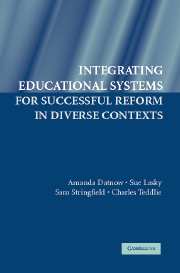Book contents
- Frontmatter
- Contents
- List of Figures and Tables
- Acknowledgments
- 1 Introduction
- 2 School Effectiveness and Improvement
- 3 District-Level Reform Efforts
- 4 Community-Level Reform Efforts
- 5 State-Level Reform Efforts
- 6 The Role of Reform Design Teams
- 7 The Role of the Federal Government in Reform Efforts
- 8 Methodological Issues in the Study of Systemic Integration for Effective Reform
- 9 Discussion and Conclusion
- Bibliography
- Index
9 - Discussion and Conclusion
Published online by Cambridge University Press: 02 September 2009
- Frontmatter
- Contents
- List of Figures and Tables
- Acknowledgments
- 1 Introduction
- 2 School Effectiveness and Improvement
- 3 District-Level Reform Efforts
- 4 Community-Level Reform Efforts
- 5 State-Level Reform Efforts
- 6 The Role of Reform Design Teams
- 7 The Role of the Federal Government in Reform Efforts
- 8 Methodological Issues in the Study of Systemic Integration for Effective Reform
- 9 Discussion and Conclusion
- Bibliography
- Index
Summary
Our goal has been to develop a greater knowledge of research on educational reform at the school, district, state, design team, community, and federal levels. Our focus in particular has been on reform in multicultural, multilingual settings, though often research studies did not have this explicit focus and we needed to intuit the implications for these students in particular. Moreover, in reviewing studies, we tend to include only research that addressed reform in more than one of the levels noted. We were interested in examining the linkages between levels, or systemic integration, because a key assumption of current moves toward systemic reform is that such integration would result in school improvement. We attempt to conceptualize the educational system as an interconnected and interdependent policy system.
In this discussion section, we attempt to synthesize what we have learned thus far regarding systemic linkages in school reform and their role in improving the educational experiences of linguistic and racial minority students. We begin with a summary of the factors that appear to be important in any educational reform effort, whether generated at the school, district, community, or federal level. As will be clear, there are implications for actions at multiple levels in most of the factors.
KEY FACTORS IN EDUCATIONAL REFORM IN MULTICULTURAL, MULTILINGUAL SETTINGS
A review of the studies discussed in this report reveal the following factors as key in educational reform in multicultural, multilingual settings.
- Type
- Chapter
- Information
- Publisher: Cambridge University PressPrint publication year: 2006

